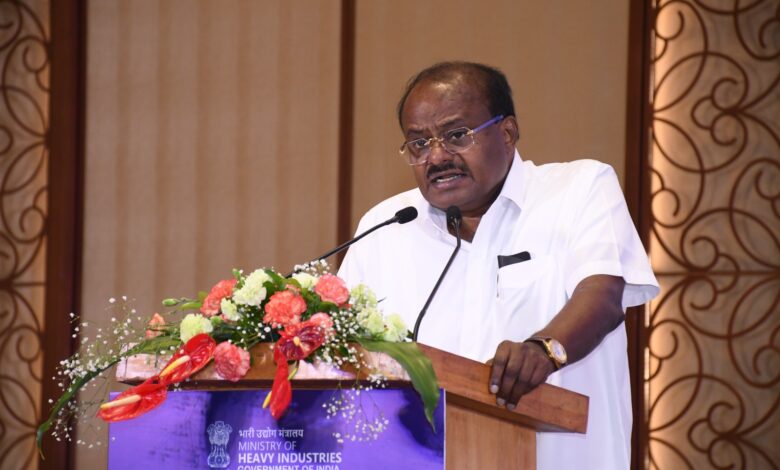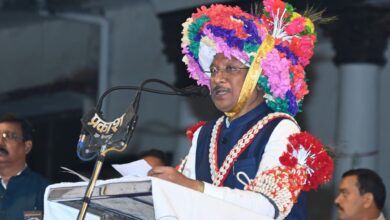India to Ensure Sufficient Charging Infrastructure for Massive EV Adoption: HD Kumaraswamy

Ruchi Tiwari/NEW DELHI : “India will ensure sufficient charging infrastructure to support the massive adoption of electric vehicles across the country,” said HD Kumaraswamy, Union Minister for Heavy Industries and Steel, at a seminar today. The Minister also announced that the Ministry of Heavy Industries will soon introduce e-vouchers for electric vehicle (EV) buyers to avail of demand incentives under the newly approved PM E-DRIVE (PM Electric Drive Revolution in Innovative Vehicle Enhancement) scheme.
Speaking at the FICCI and Ministry of Heavy Industries’ Seminar on ‘FAME’s Success in Transforming India’s EV Landscape’, Kumaraswamy outlined the government’s commitment to expanding the nation’s EV charging network. “We are ramping up charging infrastructure fast,” he stated, revealing plans to install 10,763 public charging stations across the country under the FAME-II scheme.
The introduction of e-vouchers represents a significant development in the government’s approach to promoting EV adoption. “This is a unique new feature of this new scheme,” Kumaraswamy explained. The modalities of this are in an advanced stage and will be shared with you soon.”
The PM E-DRIVE scheme, unveiled by the Union Cabinet last week, aims to accelerate EV adoption through substantial upfront incentives and the development of crucial charging infrastructure.
“Our goal is to reduce our environmental footprint, improve air quality and build a competitive and resilient electric vehicle manufacturing industry,” said Kumaraswamy.
The new PM E-DRIVE scheme introduces several novel elements, including a dedicated fund of ₹500 crore to deploy e-ambulances, an allocation of ₹500 crore to incentivise the adoption of electric trucks, and ₹2,000 crore for installing 22,000 fast chargers for electric four-wheelers, 1,800 for e-buses, and 48,400 for e-two and three-wheelers.
Reflecting on the success of FAME-II, Kumaraswamy reported that around 93 per cent of the targeted vehicles have been incentivised, with 92 per cent of the allocated ₹11,500 crore utilised. The scheme has also made significant strides in public transportation, with 4,853 e-buses supplied out of the 6,862 sanctioned for intra-city operations as of July 31, 2024.
On occasion, Shri Kamran Rizvi, Secretary, Union Ministry of Heavy Industries, said, “With the PM E-DRIVE coming, the Phased Manufacturing Programme, the domestic value addition targets will be tweaked and amended so as to take advantage of our increased capability, and so that we become a truly a world leader in electric mobility technology.”
Dr Hanif Qureshi, Additional Secretary, Ministry of Heavy Industries, stated that more than 92 per cent of the target under the FAME-II scheme has already been achieved.
FICCI President and Group CEO & MD, Mahindra Group, Dr Anish Shah, underlined FAME II as among the most transformative policies in India, noting that the electric three-wheeler industry was almost zero three years ago. “Now, the industry has gone from zero to 20 per cent, and we expect this to reach 100 per cent in the next five years,” he added.
Mr Vinod Aggarwal, Immediate Past President, SIAM and MD & CEO, VE Commercial Vehicles, noted the significant success of the FAME-II scheme in driving India’s e-mobility sector. The scheme has led to market penetration of over 5 per cent in two-wheelers, 54 per cent in three-wheelers, and 1.5 per cent in cars. Aggarwal noted that 2023-24 saw passenger EV sales increase by over 90 per cent and electric two-wheeler sales rise by more than 30 per cent compared to the previous year, highlighting the scheme’s effectiveness in accelerating EV adoption across India.
Mr Vikrampati Singhania, Vice President, ACMA & MD & Director, J K Fenner India, emphasised the auto component industry’s pivotal role in sustainable mobility. He stressed the need for innovation, R&D, and technology enhancements to maintain global competitiveness. “The EV and autonomous vehicle market demands precision and advanced components. Investing in R&D, localisation, and collaborations with startups and tech leaders will keep our industry at the forefront,” Singhania stated, highlighting the sector’s strategy for future growth.







